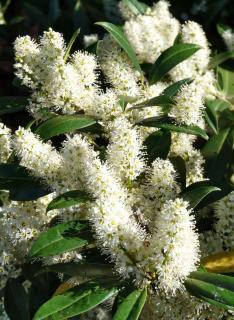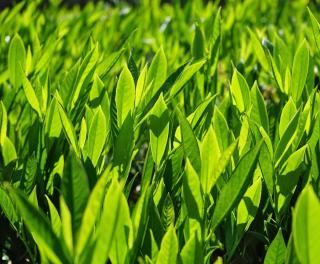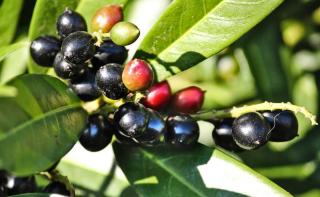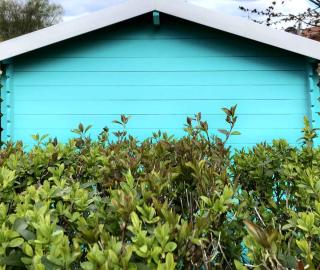

A favored hedge shrubs around many of our gardens, Prunus laurocerasus is an easy shrub to grow and care for, perfect for beginner gardeners.
Key facts :
Botanical name – Prunus laurocerasus
Synonyms – Cerasus laurocerasus
Common names – cherry laurel, common laurel, caucasian laurel
Family – Rosaceae
Type – Shrub
Foliage – evergreen
Height – 16 to 26 feet (5 to 8 meters)
Breadth – 26 to 32 feet (8 to 10 meters)
Exposure – Full sun, part sun
Soil – any type, well drained
Hardiness – very hardy (5°F/-15 °C)
Growth – fast
Flowering: spring
Fruit formation: fall
 Prunus laurocerasus is a vigorous shrub with a dense, bushy bearing that, over time, spreads outwards slowly.
Prunus laurocerasus is a vigorous shrub with a dense, bushy bearing that, over time, spreads outwards slowly.
The evergreen leaves are large (up to 6 inches/15 cm), with a fabulous shiny dark green color.
In spring, small white clusters of flowers appear. Within days, shiny red berries follow suit, somewhat similar in appearance to cherries (but they’re not edible). As time passes, the red berries turn black.
There are a great many Prunus laurocerasus varieties, but three in particular really stand out from the rest: ‘Caucasica’, ‘Rotundifolia’ and ‘Otto Luyken’. The main differences between these are the size of the leaves and the overall size of the shrub.
Prunus laurocerasus is the ideal shrub for a beginner gardener: apart from soil drainage, there’s nothing specific about the soil type to worry about. Finding the proper exposure isn’t an issue either. Moreover, its vigor and hardiness mean it can be planted nearly anywhere.
Note that to avoid possible chlorosis, it’s best to avoid excessively limestone-filled soils.
As for many plants, it’s recommended to plant your Prunus laurocerasus in fall, so that it has the time it needs to settle in before summer comes, with its probable bouts of drought. Planting in spring isn’t prohibited, but it means you have to water more often during the summertime.
No particular issues when planting common laurel: no need to prepare the soil in any manner. Simply dig a hole large enough for the root ball to fit, and set your shrub down inside. Before positioning the shrub, break the root clump up a bit to tease out a few roots.
If your soil tends to retain lots of water, feel free to spread a layer of gravel or clay marbles at the bottom of the hole before placing the shrub.
Also, but it again isn’t mandatory, you can add soil mix or ripe compost to bolster growth during the first years of your Prunus laurocerasus.
Last of all, at the end of the planting, remember to water abundantly the very first time.
Once it’s survived for a couple years, Prunus laurocerasus won’t require any specific care.
 If planted as a standalone, you won’t need to prune it. Conversely, if part of a hedge, you’ll have to prune it regularly. Though in most cases a hedge trimmer is best suited to pruning hedges, in this particular case it has a disadvantage: it chops the large leaves and wounds them. This doesn’t look very nice, and if bad comes to worse the wounds might even let diseases enter the shrub. That’s why the best way to prune Prunus laurocerasus is to use a secateur (a hand pruner) if you’ve got the time (and the patience).
If planted as a standalone, you won’t need to prune it. Conversely, if part of a hedge, you’ll have to prune it regularly. Though in most cases a hedge trimmer is best suited to pruning hedges, in this particular case it has a disadvantage: it chops the large leaves and wounds them. This doesn’t look very nice, and if bad comes to worse the wounds might even let diseases enter the shrub. That’s why the best way to prune Prunus laurocerasus is to use a secateur (a hand pruner) if you’ve got the time (and the patience).
 It’s possible to propagate Caucasian laurel through cuttings:
It’s possible to propagate Caucasian laurel through cuttings:
Fall is also a good season to start new plants from seeds.
We’ve said it was a vigorous, but Prunus laurocerasus still is vulnerable to certain diseases such as Xylella fastidiosa (the olive-tree-killing bacteria), powdery mildew and shothole blight (Coryneum beijerinckii). Note that in rare cases, armillaria root rot might be the reason your common laurel is dying off.
As for insects, you’ll most certainly discover red spider mites and black vine weevils that attack leaves.
 With the dense foliage and rapid growth, the most common landscaping use of cherry laurel is in trimmed hedges. However, this particular use doesn’t highlight the shrub itself, which would occasionally deserve to be grown as a standalone in a garden, or let loose among other shrubs in a large shrub bed.
With the dense foliage and rapid growth, the most common landscaping use of cherry laurel is in trimmed hedges. However, this particular use doesn’t highlight the shrub itself, which would occasionally deserve to be grown as a standalone in a garden, or let loose among other shrubs in a large shrub bed.
Finally, thanks to the ease of its care and to how simple it is to grow, Prunus laurocerasus is the ideal candidate for setting up a garden with no needed maintenance.